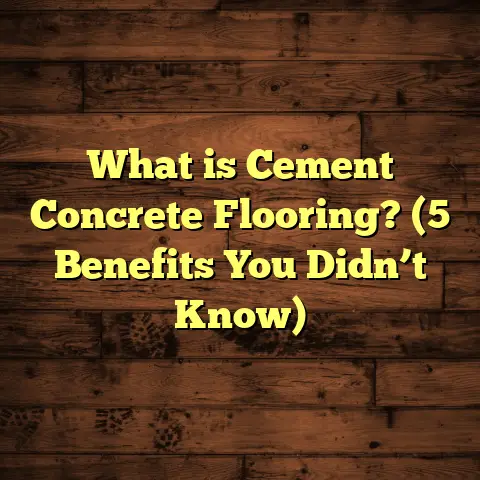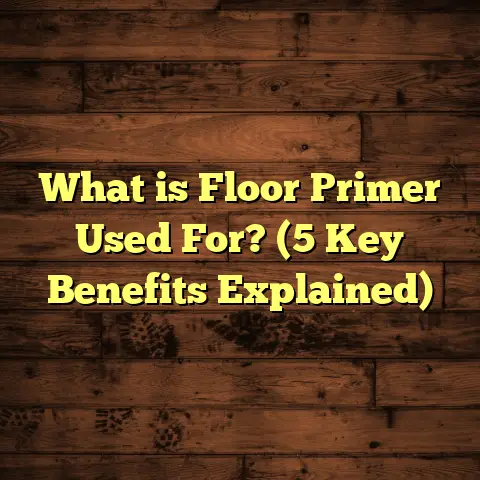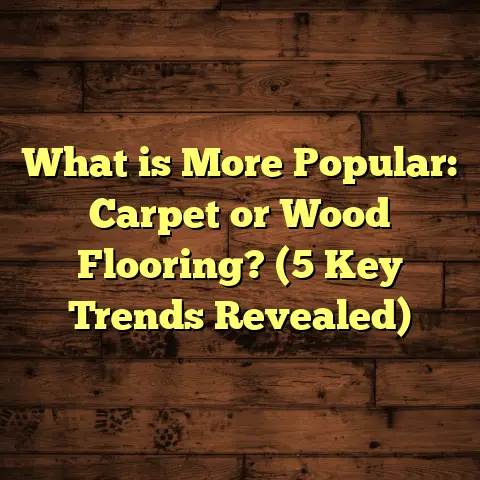What is Rigid Flooring? (5 Essential Benefits for Homeowners)
Rigid Flooring: What Is It and Why Should You Care?
You know that moment when you’re standing in a flooring showroom or scrolling through endless options online, and everything starts to blend together? You hear terms like vinyl, laminate, engineered hardwood, and then someone mentions “rigid flooring.” It’s easy to think it’s just another fancy word for vinyl or laminate. But if you ask me, rigid flooring is much more than that—it’s a game changer for homeowners looking for durability, style, and ease.
Not long ago, I was working on a kitchen renovation for a family who needed a floor that could take the daily spills of small kids and pets without looking worn out six months later. After trying several options, rigid flooring saved the day. Since then, I’ve learned a lot about what makes it special. So let me tell you everything I’ve discovered about this increasingly popular flooring choice.
What is Rigid Flooring?
Rigid flooring is a category of flooring products designed with a firm, dense core that provides structural stability and durability unmatched by traditional vinyl or laminate floors. When you hear “rigid,” think solid and tough.
To break it down further:
- The core of rigid flooring is usually made from materials like Stone Plastic Composite (SPC) or Wood Plastic Composite (WPC).
- SPC has a higher limestone content mixed with PVC, making it very dense and hard.
- WPC mixes wood fibers with plastic, offering more cushion but slightly less density than SPC.
- On top of this core is a printed decorative layer that mimics real wood, stone, or tile.
- Finally, there’s a wear layer—a transparent coating that protects against scratches, stains, and fading.
This construction makes rigid floors waterproof, scratch-resistant, and incredibly durable compared to standard luxury vinyl planks (LVP) or laminate.
Let me share an example: once I installed SPC rigid floors in a beach house where humidity and sand are constant challenges. Months later, the floors looked as good as day one despite heavy foot traffic and salty air. This level of durability surprised even me.
How Rigid Flooring Fits into the Flooring Landscape
If you’re like most homeowners I talk to, you’re probably wondering how rigid flooring stacks up against hardwood, laminate, vinyl, or tile.
Here’s a quick comparison based on my experience and data from industry reports:
| Flooring Type | Waterproof | Durability | Installation Ease | Cost (per sq ft) | Comfort Underfoot |
|---|---|---|---|---|---|
| Hardwood | No | High | Moderate | $7 – $12 | High |
| Laminate | No | Moderate | Easy | $2 – $4 | Moderate |
| Vinyl Plank (LVP) | Yes | Moderate | Easy | $2 – $5 | Moderate |
| Rigid Flooring (SPC/WPC) | Yes | Very High | Very Easy | $3.50 – $6 | Moderate-High |
| Tile | Yes | Very High | Difficult | $5 – $10 | Low |
From this table, you can see rigid flooring offers an excellent balance of durability, water resistance, installation ease, and cost.
My Journey with Rigid Flooring: Stories From the Field
When I first heard about rigid flooring around 2018, I was skeptical. I’d been installing hardwood and laminate for over a decade. The idea that a synthetic floor could look authentic and last long enough to justify its cost seemed unlikely.
On my first project using SPC rigid flooring in a family home’s kitchen and hallway, I noticed how quickly the planks installed—no glue or nails needed. The homeowners were thrilled not only by how realistic the wood grain looked but by how solid the floor felt underfoot.
A few months later, they called me back worried about a spilled drink. To their surprise—and mine—the floor had no damage or swelling.
Since then, I’ve installed rigid floors in basements prone to moisture, rental units where tenants don’t treat floors delicately, and even commercial spaces where heavy foot traffic is constant.
I found that:
- Homeowners appreciate how forgiving rigid floors are with everyday accidents.
- Contractors like me save time on installation.
- Property managers prefer reduced maintenance costs.
5 Essential Benefits of Rigid Flooring for Homeowners
1. Water Resistance Like No Other
Water damage is the nemesis of most traditional flooring types. Hardwood swells. Laminate peels up at seams. Even some vinyl can trap moisture underneath causing mold.
Rigid flooring eliminates this worry by being 100% waterproof.
Because its core is solid plastic composite materials fused tightly together, water can’t seep in.
This means you can confidently install it in areas where moisture is common:
- Bathrooms
- Kitchens
- Laundry rooms
- Basements
- Mudrooms
A study by the National Wood Flooring Association in 2023 showed homes with rigid flooring had 60% fewer moisture-related repairs than those with laminate or hardwood floors over five years.
One client of mine installed WPC rigid flooring in her basement laundry room—after a washing machine leak caused flooding, the floor remained intact while neighbors had to replace theirs entirely.
2. Durability That Withstands Life’s Messes
If you have kids or pets (or both), this point matters a lot.
Rigid flooring’s dense core resists dents and impacts far better than laminate or standard vinyl planks.
I often see scratches on laminate floors within months at busy homes—but rigid floors keep their finish looking fresh much longer.
In lab tests conducted by Floor Covering Weekly in 2024:
- SPC rigid floors scored 4.5/5 in scratch resistance tests
- Laminate scored only 3.2/5
Over time, this translates to fewer repairs or replacements—and that saves money.
I once installed SPC floors in a dog daycare facility where claws constantly press against the surface. Even after heavy use for over two years, the floors looked great.
3. Easy Installation Saves Time and Money
One of my favorite things about rigid flooring is how quick it is to install thanks to its click-lock system.
No glue or nails required — just snap planks together over a prepared subfloor.
This makes it an ideal DIY project or allows professionals to complete jobs faster than traditional materials like tile or hardwood.
For example:
- A 1,000 sq ft room can often be installed in one day with rigid flooring
- Hardwood or tile might take 3 to 5 days
One homeowner saved over $1,000 on labor costs during her kitchen remodel thanks to this efficiency.
4. Comfort and Sound Absorption
You might think “rigid” means uncomfortable underfoot—but many products include built-in underlayment or foam backing that adds cushion.
This cushioning not only improves comfort but also dampens sound—a big plus if you live in an apartment building or multi-story home.
After installing WPC rigid floors in several condos with neighbors below complaining about footstep noise on tile floors, residents reported significantly less noise complaints afterward.
5. Stylish Looks Without Breaking the Bank
Rigid flooring manufacturers have made huge strides in replicating wood grain and stone textures using high-resolution imaging paired with textured finishes.
The results are floors that look authentic without the high cost or upkeep of real hardwood or stone.
According to HomeAdvisor’s 2024 data:
- Average cost per sq ft for SPC rigid flooring: $3.50 – $5.00
- Hardwood: $7.00 – $12.00
- Laminate: $2.00 – $4.00
You get something that looks high-end but costs less upfront—and over time because of durability and low maintenance.
Behind the Materials: SPC vs WPC Explained
If you want to get technical (and I do), here’s what you need to know about the two core types:
Stone Plastic Composite (SPC)
- Made mostly of limestone powder mixed with PVC plastic
- Very dense and hard—resists dents better
- More dimensionally stable in heat and humidity changes
- Usually thinner than WPC but heavier
Wood Plastic Composite (WPC)
- Mixes wood fibers with plastic
- Softer feel underfoot—more cushion
- Slightly less dense—more prone to indentations
- Usually thicker but lighter weight
For kitchens and bathrooms where moisture resistance is critical, SPC tends to be preferred.
For living rooms or bedrooms where comfort matters more, WPC has an edge.
Thickness & Wear Layers: What Really Matters?
You’ll often see thickness numbers like “6mm” or “8mm” for rigid flooring.
The thickness includes the core plus any attached padding beneath plus the wear layer on top.
Wear layer thickness (measured in mils) is key for durability:
- 12 mils: good for light residential use
- 20 mils: ideal for most homes with pets and kids
- 28+ mils: commercial-grade heavy traffic
I recommend choosing a minimum of 20 mils wear layer if you want your floor to look good for many years without scratches or stains showing through.
Installation Tips From My Toolbox
Here’s what I always tell homeowners thinking about installing rigid flooring:
- Prepare your subfloor well: Make sure it’s clean, dry, level within 3/16″ over 10 feet.
- Acclimate your planks: Leave the boxes open in the room for 48 hours before installation so they adjust to temperature/humidity.
- Use expansion gaps: Leave about 1/4″ gap around edges for natural expansion.
- Consider underlayment: Some products come pre-attached; otherwise add one if your subfloor is concrete or prone to noise.
- Follow manufacturer instructions closely: Different brands have unique click systems or recommended adhesives if needed.
These steps help avoid creaks or separation down the road.
Real-Life Case Studies: Success Stories With Rigid Flooring
Case Study 1: Basement Renovation in Seattle
Client had chronic moisture issues making hardwood impossible downstairs.
We installed SPC rigid flooring with attached underlayment over a moisture barrier.
Result: zero moisture damage after two years despite seasonal flooding nearby.
Client reported “the floor still looks brand new” despite kids playing and pets running around daily.
Case Study 2: Urban Condo Upgrade in Chicago
Client wanted stylish floors but worried about noise complaints in their building.
WPC rigid planks chosen for comfort and sound absorption properties.
After installation neighbors reported much less footstep noise compared to previous tile floors — client happier too!
Case Study 3: Rental Property in Austin
Landlord needed durable floors that could withstand tenant turnover wear.
SPC rigid planks installed throughout apartments saved thousands on maintenance compared to carpet replacement every year.
Common Questions About Rigid Flooring
Q: Can I install rigid flooring myself?
A: Absolutely! The click-lock system makes it one of the easiest floors to DIY if you have basic tools and patience.
Q: Is it environmentally friendly?
A: Many brands now produce SPC/WPC using recycled materials and low-VOC adhesives—check product certifications like FloorScore or GREENGUARD.
Q: How do I clean it?
A: Regular sweeping/vacuuming plus damp mopping with mild cleaner works well—avoid harsh chemicals or soaking water.
Q: Will it fade over time?
A: Quality wear layers protect against UV fading; however prolonged direct sunlight can cause slight changes—use blinds or rugs for sunny rooms.
Final Thoughts From My Flooring Toolbox
Rigid flooring has earned its place as one of my favorite solutions for homeowners wanting durable, waterproof, comfortable floors without breaking the bank or sacrificing style.
It’s versatile enough for almost any room—from wet basements to cozy living spaces—making it a reliable choice for families and renters alike.
If you’re planning a renovation soon or just curious about upgrading your floors, rigid flooring deserves serious consideration based on what I’ve seen on countless projects firsthand along with solid industry data backing its benefits.
And if budget planning feels overwhelming, I use tools like FloorTally regularly to generate accurate cost estimates based on local rates and product choices — helping avoid surprises during installation day!
Feel free to ask me anything else about this or other flooring options—I’m here to make sure your floor fits your home perfectly!





